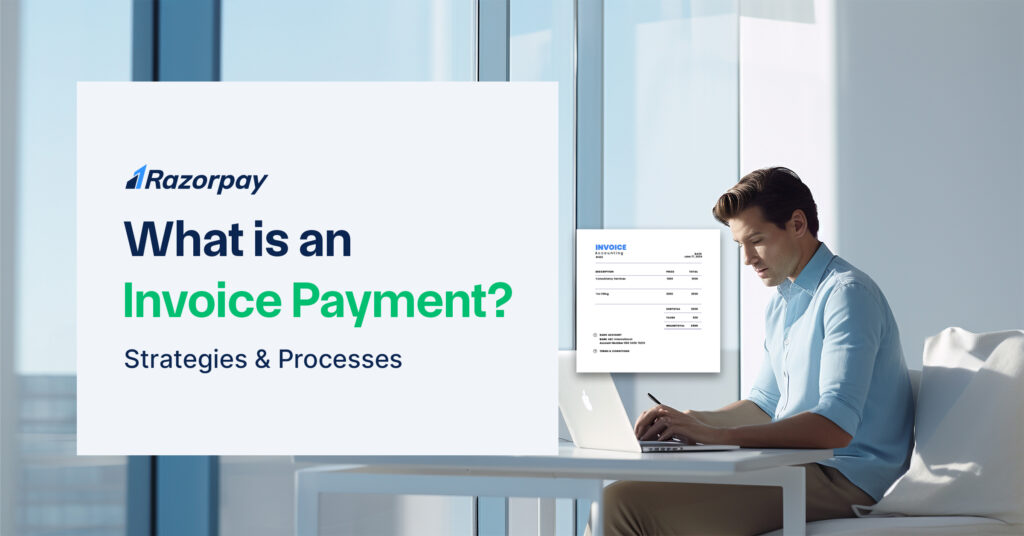Table of Contents
What is an Invoice Payment?
An invoice payment is a scheduled payment initiated by a customer to pay off the balance due for goods or services they have received from a merchant. It includes essential details like the goods or services sold, the payable amount, the invoice number, the date, quantities, tax information, payment terms, and credit terms.
Related Read: How to Send an Invoice? A Step-by-Step Guide
How Does the Invoice Payment Process Work? A-Step-by-Step-Guide
The invoice payment process typically involves the following steps:
STEP 1: Invoice Capture
- Receiving invoices: This can be done through fax, mail, email, or an accounts payable system.
- Data entry: The invoice details are entered into the accounts payable system.
- Automation: AP automation can be used to streamline the process and reduce errors.
STEP 2: Invoice Approval
- Checking details: The invoice details, amounts, and coding are verified.
- Authorized team member: This step is typically handled by an authorized team member.
STEP 3: Payment Authorisation
- Review and approval: The invoice is reviewed by designated personnel (controller or CFO).
- Payment authorization: They give the green light for payment.
STEP 4: Payment Execution
- Payment method selection: Choose a payment method (checks, ACH transfers, virtual cards).
- Payment processing: The payment is executed according to the selected method.
- Integration with online payment gateways: Businesses can process payments faster and more securely by utilizing online payment gateways, especially for digital transactions.
STEP 5: Archive
- Storing invoices: The invoices are stored for future reference.
Related Read: What Is Automated Invoice Processing and How to Implement It?
Different Methods for Making Invoice Payments
1. Cash Payment
- Physical currency: Invoices are settled with cash.
- Limited use: Suitable for small amounts and remote transactions.
2. Check Payments
- Traditional method: Checks are still used, especially for businesses.
- Process: A check is written and posted to the supplier.
- Drawbacks: Can be slow, costly, and subject to delays.
3. Virtual Cards
- Digital alternative: Virtual cards are digital versions of credit cards.
- Unique code: Generate a unique 16-digit code for one-time use.
- Security: Offers enhanced security compared to other methods.
- Online transactions: Ideal for online transactions.
4. ACH Payments (Bank Transfers)
- Electronic transfers: ACH payments are transferred between bank accounts via the ACH network.
- Benefits: Cost-effective, secure, and faster than checks.
- Common use: Widely used for recurring payments and large transactions.
5. Electronic Funds Transfer (EFT)
- Direct transfer: EFT involves a direct transfer of funds between bank accounts.
- International payments: Often used for international payment gateway.
6. Mobile Payment Apps
- Digital wallets: Apps like Apple Pay, Google Pay, and Samsung Pay allow for contactless payments.
- Convenience: Offer convenience and security for in-person transactions.
7. Online Payment Platforms:
- Web-based payments: Platforms like PayPal and Stripe facilitate online payments.
- Global reach: Used for both domestic and international transactions
Related Read: What is Invoice Factoring and How Does It Work?
Strategies for Effective Invoice Payments
1. Strategic Payment Scheduling
1.1 Timely payments
Ensure prompt payment to maintain positive supplier relationships and avoid late fees.
1.2 Aligned schedule
Develop a payment schedule that aligns with your cash flow to optimize financial management.
1.3 Reminders and alerts
Utilize reminders or calendar alerts to stay organized and avoid missed due dates.
2. Leveraging Automation
2.1 Streamlined process
2.2 Error reduction
2.3 Integrated systems
3. Effective Negotiation
3.1 Mutual benefits
Discuss payment terms with suppliers to find mutually beneficial arrangements.
3.2 Flexible options
Explore options like early payment discounts or extended payment periods.
3.3 Clear communication
Maintain open communication to establish favorable terms for both parties.
4. Adopting Digital Solutions
4.1 Faster processing
Embrace digital payment methods like ACH transfers or virtual cards for quicker processing times.
4.2 Enhanced security
Benefit from the improved security features offered by digital payment solutions.
4.3 Efficient tracking
Gain better visibility and tracking capabilities with digital payment methods.
4.4 Software integration
Ensure compatibility with your accounting software for simplified reconciliation.
5. Continuous Improvement
5.1 Regular assessment
Periodically review your payment processes to identify areas for improvement.
5.2 Identify bottlenecks
Pinpoint inefficiencies or bottlenecks in your current system.
5.3 Stay updated
Stay informed about emerging payment technologies that can enhance your business operations.
Related Read: What is Invoice Reconciliation and How to Reconcile Invoices?
Challenges in Invoice Payments
1. Delayed Payments
- Strained relationships: Late payments can damage supplier relationships.
- Disrupted cash flow: Delays can disrupt cash flow and lead to late fees.
- Inefficient processes: Inefficient processes or cash flow issues often contribute to late payments.
2. Invoice Discrepancies
- Errors and missing information: Incorrect amounts or missing data can cause payment delays.
- Time-consuming reconciliation: Discrepancies require time-consuming reconciliation, slowing down the payment process.
3. Complex Payment Processes
- Bottlenecks: Multi-step approvals and manual data entry can create bottlenecks.
- Increased risk of errors: Complex processes increase the likelihood of errors and delays.
4. Currency and Exchange Rate Issues
- Fluctuating rates: International transactions can be complicated by fluctuating exchange rates.
- Unexpected costs or gains: Volatility can lead to unexpected financial impacts.
5. Fraud and Security Risks
- Missing invoices: Missing invoices can be a sign of fraud or data loss.
- Invoice fraud: Fake invoices, intercepted payments, or compromised payment systems pose significant risks.
- Security threats: Cybersecurity threats can lead to financial losses and data breaches.
6. Invoice Management Challenges
- Missing invoices: Lost or misplaced invoices can cause delays and confusion.
- Poor visibility: Lack of visibility into invoice status can hinder payment management.
7. Invoice Processing Delays
- Manual processes: Manual processing can be time-consuming and error-prone.
- Lack of automation: Insufficient automation can contribute to delays.
8. Compliance Issues
- Non-adherence to regulations: Failure to comply with regulations can lead to penalties and legal issues.
- Inefficient processes: Complex processes can make it difficult to adhere to compliance requirements.
9. Double Payment
-
- Duplicate payments: Accidental or fraudulent double payments can lead to financial losses.
- Reconciliation challenges: Identifying and resolving double payments can be time-consuming.
Related Read: What is Invoice Trading?
Conclusion
Effective invoice payment management is crucial for businesses to maintain healthy financial operations and foster strong supplier relationships. By understanding the various methods for making invoice payments, implementing efficient strategies, and addressing potential challenges, organizations can streamline their payment processes and ensure timely and accurate settlements.
FAQs
1. What are the benefits of paying invoices on time?
Timely invoice payments help maintain good supplier relationships and can lead to better terms or discounts. They also prevent late fees and potential legal issues.
2. How long do businesses usually have to pay an invoice?
Payment terms vary but typically range from ‘net 30’ to ‘net 90’. However, some industries or specific agreements might have shorter or longer payment windows.
3. How can I track the status of an invoice payment?
Most modern accounting software offers real-time tracking of invoice statuses. You can also use online banking portals to check payment statuses. For manual processes, maintaining a well-organised payment log and regularly communicating with your accounts payable team can help track payments.
4. Can invoices be paid automatically through recurring billing or direct debit?
Yes, invoices can be paid automatically through recurring billing or direct debit. Both methods save time and ensure you never miss a payment, making things easier for everyone involved.
5. Are there any security measures in place to protect invoice payment information?
Reputable payment systems use encryption and tokenisation to protect sensitive data. Two-factor authentication is often employed for added security. It’s crucial to use trusted payment platforms and follow best practices like regularly updating passwords and monitoring accounts for unusual activity.
6. What are the benefits of automating invoice payments?
Automation reduces manual errors, speeds up processing times, and improves cash flow management. It can lead to significant time and cost savings, especially for businesses handling large volumes of invoices.
7. How do international payments affect invoice processing?
International payments can complicate invoice processing due to currency conversions, different banking systems, and varying regulations. They may involve additional fees and longer processing times.


